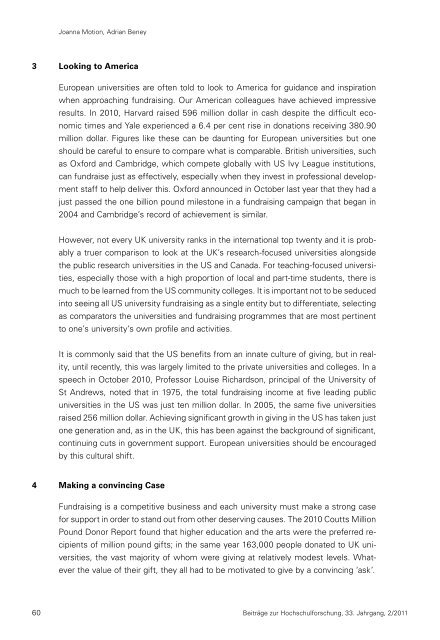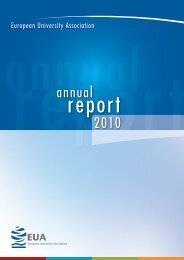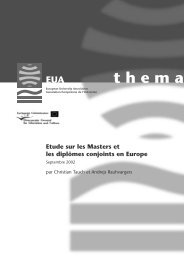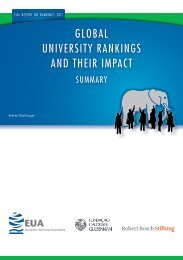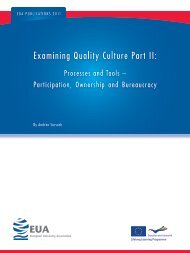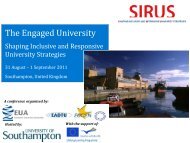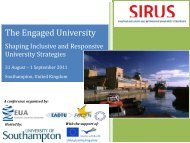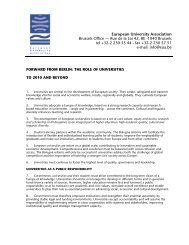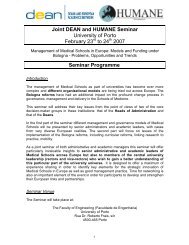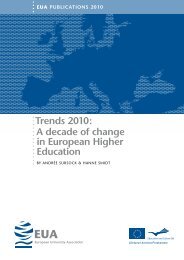Beiträge zur Hochschulforschung - European University Association
Beiträge zur Hochschulforschung - European University Association
Beiträge zur Hochschulforschung - European University Association
You also want an ePaper? Increase the reach of your titles
YUMPU automatically turns print PDFs into web optimized ePapers that Google loves.
60<br />
Joanna Motion, Adrian Beney<br />
3 Looking to America<br />
<strong>European</strong> universities are often told to look to America for guidance and inspiration<br />
when approaching fundraising. Our American colleagues have achieved impressive<br />
results. In 2010, Harvard raised 596 million dollar in cash despite the difficult eco-<br />
nomic times and Yale experienced a 6.4 per cent rise in donations receiving 380.90<br />
million dollar. Figures like these can be daunting for <strong>European</strong> universities but one<br />
should be careful to ensure to compare what is comparable. British universities, such<br />
as Oxford and Cambridge, which compete globally with US Ivy League institutions,<br />
can fundraise just as effectively, especially when they invest in professional develop-<br />
ment staff to help deliver this. Oxford announced in October last year that they had a<br />
just passed the one billion pound milestone in a fundraising campaign that began in<br />
2004 and Cambridge’s record of achievement is similar.<br />
However, not every UK university ranks in the international top twenty and it is prob-<br />
ably a truer comparison to look at the UK’s research-focused universities alongside<br />
the public research universities in the US and Canada. For teaching-focused universi-<br />
ties, especially those with a high proportion of local and part-time students, there is<br />
much to be learned from the US community colleges. It is important not to be seduced<br />
into seeing all US university fundraising as a single entity but to differentiate, selecting<br />
as comparators the universities and fundraising programmes that are most pertinent<br />
to one’s university’s own profile and activities.<br />
It is commonly said that the US benefits from an innate culture of giving, but in real-<br />
ity, until recently, this was largely limited to the private universities and colleges. In a<br />
speech in October 2010, Professor Louise Richardson, principal of the <strong>University</strong> of<br />
St Andrews, noted that in 1975, the total fundraising income at five leading public<br />
universities in the US was just ten million dollar. In 2005, the same five universities<br />
raised 256 million dollar. Achieving significant growth in giving in the US has taken just<br />
one generation and, as in the UK, this has been against the background of significant,<br />
continuing cuts in government support. <strong>European</strong> universities should be encouraged<br />
by this cultural shift.<br />
4 Making a convincing Case<br />
Fundraising is a competitive business and each university must make a strong case<br />
for support in order to stand out from other deserving causes. The 2010 Coutts Million<br />
Pound Donor Report found that higher education and the arts were the preferred re-<br />
cipients of million pound gifts; in the same year 163,000 people donated to UK uni-<br />
versities, the vast majority of whom were giving at relatively modest levels. What-<br />
ever the value of their gift, they all had to be motivated to give by a convincing ‘ask’.<br />
<strong>Beiträge</strong> <strong>zur</strong> <strong>Hochschulforschung</strong>, 33. Jahrgang, 2/2011


